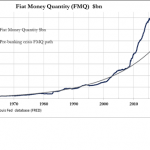Commodity losses

 Markets have been extraordinarily complacent about the bad debts building up in the financial system.
Markets have been extraordinarily complacent about the bad debts building up in the financial system.
In the wake of the Fed’s decision to raise interest rates this week, the effect on debt was barely mentioned in the subsequent analysis by any of the mainstream media’s talking heads. Establishment economists are even claiming that in 2016 we can now gradually get back to more normal interest rates of three or four percent as the US economy continues its recovery. This simply cannot happen when one considers the effect on outstanding debt.
In considering the debt position, one should start by asking a very basic question: of total global debt, which currently exceeds $200 trillion equivalent, how much has been taken out without any intention of repaying it? We know that nearly all governments never intend to repay debt, instead looking to roll it, add to it, and inflate it away. Household debt continues to build in aggregate, and we know that the easiest way to make money is to take out a mortgage and buy a home. And how many company treasurers think about actually reducing debt, as opposed to refinancing it? One could go on, but the point is that monetary inflation has turned us all into habitual borrowers and debt continues to compound.
Complacency and markets are a dangerous combination. So far, there have been some rumblings about the position of lower quality borrowers with junk status. But even here, no one worries much, dismissing it as a liquidity problem. Note the evasion: the problem is not regarded to be the borrowers so much as market liquidity. Well, there is now a real issue that challenges this complacency, and that is commodity-related debt.
Energy-related liabilities are where most of the trouble lies. The annualised gross value of oil sales has fallen during 2015 by about $2 trillion. The effect on oil company profits and the decline in tax revenue for oil exporting countries is obvious. The effect on suppliers, ancillary businesses and retailers in the vicinity of oil production is perhaps less so. But the biggest problem for the oil industry is the loss of cash-flow to support the debt that has financed the investment and working capital involved. And because oil is priced in dollars, most of this debt is also denominated in dollars, not in local currencies that can be devalued to depreciate the debt.
No wonder OPEC members are feeling the pain, made worse by having the screw tightened with a strong dollar. And no wonder their response is to get the stuff out of the ground as quickly as possible, knocking the price even more. After years of higher prices, government expenditures have risen to meet the income available. Lower prices throw up losses in state finances that become politically destabilising for even the lowest cost producers, and it has now become a question of political survival for many OPEC member governments, including the likes of Saudi Arabia. This strict Sunni state is losing its fight against the Shias to the north, and the Yemeni Shias are making inroads from the south. Furthermore, the majority of oilfield workers are also Shia. The Saudi’s traditional way of containing the political situation is to throw money at it, money that’s no longer there.
Oil is by far the important generator of losses in the commodity world, but other industrial commodity prices have also fallen, not so dramatically perhaps. Nevertheless, the corporate strains are showing, with blue-chip companies such as Anglo-American cutting their operations and laying off huge numbers of workers. If the Anglo-Americans and Glencores of this world are downsizing, imagine the plight of the smaller fry. These are all commodity businesses, owing dollars, whose cash-flow assumptions have gone badly awry. The point to be made is that if you miss a price expectation by 10% it is painful, but if you have three or four years of falling prices, you end up with a debt problem many multiples of the revenue lost.
Commodity-related debt is therefore substantial and very heavily angled towards dollars. Leveraged extraction companies have borrowed from leveraged banks, ensuring that the banks have the problem as well. Total US bank equity capital is estimated to be $1.77 trillion, probably less than a quarter of global commodity-related USD-denominated debt.
The crisis engulfing commodity financing is the reason why complacency over debt has become acutely dangerous. The world’s debt burden has now increased to the point where interest rates, as set by central banks, do not have to rise at all to trigger a downturn in the credit cycle. All that is needed is an increase in risk aversion. With yield differentials between US Treasuries and corporate bonds increasing, that time appears to have arrived for the world’s reserve currency.
That is not all. China’s foreign exchange policy is unhelpful, perhaps deliberately so. By setting the yuan peg lower, she is effectively forcing the dollar to revalue, exacerbating a growing bad debt problem. China can do this because her economy measured on a purchasing power parity basis is larger than that of the US, and she dominates international trade.
There are two basic reasons why this strategy suits China. Firstly, she is a net holder of dollar deposits and Treasury bonds, and it therefore makes sense for China to encourage the wealth transfer effect of exchange rate changes to work for her benefit. This is achieved directly through an increase in the value of her dollar balances measured in yuan, and indirectly through lower dollar prices for commodities, so the combined benefit to China of forcing a dollar revaluation is considerably greater than the marginal benefit on a few trillion dollars. And secondly, destabilising the finances of international companies, markets and banks that account in dollars, serves to weaken the dollar’s hegemonic status in the longer term by encouraging global business to match their liabilities to the currencies of their trading partners instead of the reserve currency.
What happens now after the Fed’s small rate increase will be much more challenging than the media’s talking heads would have us believe. It is not even clear how aware the Fed is of its own helplessness. The Fed has very little room for manoeuvre because of the dollar debt bubble that threatens to implode, and US monetary policy is effectively being controlled by China through the foreign exchange markets. These two issues have forced the Fed into the role of a bystander observing its own crisis.
By Alasdair Macleod, www.goldmoney.com
Find more: Contributing Authors




























